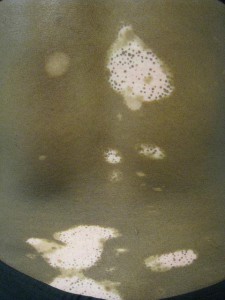Vitiligo
Shalini Reddy, MD, Evelyn Lilly, MD, and Roopal V. Kundu, MD
 Vitiligo is a disorder in which areas of skin lose color and become white (depigmented). Areas that are commonly affected include the skin around the eyes and mouth, fingers/toes, elbows, knees, lower back, and genitals. Depigmented areas may also appear at sites of injury or sunburn. Although vitiligo may begin rapidly, the disease usually slows or stops over time. Some patients have noted worsening of vitiligo with illness or emotional stress.
Vitiligo is a disorder in which areas of skin lose color and become white (depigmented). Areas that are commonly affected include the skin around the eyes and mouth, fingers/toes, elbows, knees, lower back, and genitals. Depigmented areas may also appear at sites of injury or sunburn. Although vitiligo may begin rapidly, the disease usually slows or stops over time. Some patients have noted worsening of vitiligo with illness or emotional stress.
Whom does vitiligo affect?
Vitiligo affects 0.5 to 1 percent of the population. Men and women of all races are equally affected. However, depigmentation is more prominent in people with darker skin. The disease may begin at any age, with approximately half of all individuals noticing loss of pigment before age 20.1
What causes vitiligo?
Vitiligo is caused by the destruction of melanocytes, which are cells in the skin that produce pigment.1 Scientists are not sure why melanocytes die, but they believe it is likely due to multiple factors, including genetics, stress, and autoimmunity (the body’s own immune system attacking melanocytes). Patients with vitiligo often have a personal or family history of autoimmune diseases, such as thyroid disease, alopecia areata, juvenile diabetes, or vitiligo itself.
How do I know if I have vitiligo?
Your dermatologist can diagnose vitiligo by taking a medical history and performing a thorough physical examination with a special light called the Wood’s lamp, which highlights depigmented skin. Other conditions may cause the skin to appear light, but vitiligo is one of the only conditions that will cause a total loss of pigment.
What are the best treatments for vitiligo?
Sun protection and broad spectrum sunscreen (sunscreen which protects against ultraviolet A and B waves) are important because it both protects the white areas, which sunburn easily, and also limits tanning of normal skin, to minimize contrast between the normal and depigmented skin. Minimizing sun exposure with wide-brimmed hats, sun-protective clothing, and avoidance of intense sun exposure (i.e. mid-day sun) is also important. Individuals with vitiligo can also use cosmetic cover-up and tanning agents such as dihydroxyacetone (DHA) to help protect the skin.
There are several treatments that attempt to repigment the skin. If the depigmented areas are small, topical medications, like steroids or calcineurin inhibitors may be recommended. Topical steroids can cause the skin to atrophy (become too thin), so they must be used under a doctor’s guidance. For more widespread areas, light therapy, most commonly narrowband ultraviolet B (NBUVB) therapy may be more effective. Repigmentation usually begins near the hair follicles and spreads outward, with the appearance of darker spots of pigment in the affected areas during treatment. Individuals with stable, limited disease that does not respond to other medical treatments may be candidates for surgical options, such as mini-grafting, where physicans graft tiny amounts of donor skin from an unaffected region to the affected region.
Individuals who fail these therapies or have large areas of vitiligo may consider depigmenting or “bleaching” the unaffected skin. Depigmentation can be achieved chemically with the prescription cream 20% monobenzone. This depigmentation process is permanent, and areas of normal skin will appear the color of the areas affected by vitiligo.
Download Spanish translation.
Descarga traducción en español.
Other Resources:
National Vitiligo Foundation, Inc.
American Vitiligo Research Foundation, Inc.
Global Vitiligo Foundation
Vitiligo Research Foundation, Inc.
Vitiligo Friends – Online Support Group
Vitiligo Support International, Inc. – Online Support Group
References
- Alikhan A, Felsten LM, Daly M, Petronic-Rosic V. Vitiligo: a comprehensive overview Part I. Introduction, epidemiology, quality of life, diagnosis, differential diagnosis, associations, histopathology, etiology, and work-up. Journal of the American Academy of Dermatology. 2011;65(3):473-91.
- Taieb A, Picardo M. Clinical practice. Vitiligo. The New England Journal of Medicine. 2009;360(2):160-9.
- . Felsten LM, Alikhan A, Petronic-Rosic V. Vitiligo: a comprehensive overview Part II: treatment options and approach to treatment. Journal of the American Academy of Dermatology. 2011;65(3):493-514.
- Taeib A, Alomar A, Bohm M, Dell’anna ML, De Pase A, Eleftheriadou V, et al. Guidelines for the management of vitiligo: the European Dermatology Forum consensus. The British Journal of Dermatology. 2013;168(1):5-19.

Cutis Journal
Read published peer-reviewed articles written your by Skin of Color Society members

Did You Know
Skin of color patients comprise the majority in California, New Mexico and Texas…and soon will be the majority in Arizona, Nevada, Georgia, New York and Florida.
By 2042, more than 50% of the US population will have skin of color.




